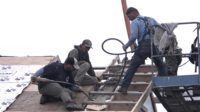A spokesman for Capital Safety does much more than sell only off-the-shelf products. "We are working in the field with customers on a daily basis and fill thousands of custom orders each year." he says. "We are always talking to customers and then designing solutions to fit their needs."
Man of Many Trades
In his two decades in construction Wilhammer had worked as a painter, carpenter, landscaper, and supervisor of large construction projects.
At 6 ft, 5 in. and 255 lbs, Willhammer had found safety harnesses he had used very uncomfortable with straps that chafe. In creating his own harness, which has its own tool belt built into it, he came to believe that most conventional harnesses have straps that work to pull a worker’s body apart.
So he set out to create a harness that cushioned the body and inflicted no injury when the worker was stranded in a dangling harness waiting to be rescued.
After Willhammer’s invention was featured on Invention USA on the History Channel, he was contacted by the United Steelworkers of America, Shell Oil and Otis Elevator. “Everybody wanted the lighter, cheaper version,” he says.
Harnesses can cost from $160 to $400. At $199.99, Wilhammer's Fall Master weighs just 3.5 pounds, and also has four grooves of webbing loops so a worker who’s fallen can be cut free and lowered down safely. The harness has a seat built into it.
“By putting a seat into the harness, it drops the angle of the leg pads. The back-brace holds the inertia [of a fall], and with the seat it distributes the inertia all over,” Willhammer says.
“They say 15 to 17 people on average die each day from falls in the construction industry,” Willhammer says. Despite having worked construction in more than 20 states, Willhammer never was given any safety harness training. “I think employers should give non-union employees a day of harness training,” Willhammer says.
He has a training video for his harnesses, and is trying to create a national Safety Harness Safety Day. He also is working to get his harness UL listed, although he says it’s already approved by U.S. Occupational Safety and Health Administration and the American National Standards Institute.




Post a comment to this article
Report Abusive Comment